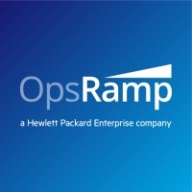

HPE OneView and OpsRamp compete in the IT infrastructure management category. OpsRamp seems to have an edge with strong cloud platform integration and effective customer service.
Features: HPE OneView offers automation and centralized management, simplifying VLAN integration and streamlining management across various infrastructure components. OpsRamp is versatile, integrating with multiple cloud platforms and ensuring efficient infrastructure visibility. Both products deliver valued automation, with HPE focusing on physical hardware and OpsRamp on virtual environments.
Room for Improvement: HPE OneView needs enhanced integration with non-HPE hardware, refined role-based access controls, and better alert management. OpsRamp could improve its automation and ITSM maturity, reduce false alerts, and enhance its dashboard customization and reporting functionalities.
Ease of Deployment and Customer Service: HPE OneView is primarily deployed in on-premises environments and has mixed reviews regarding technical support. OpsRamp operates in public cloud environments and receives generally favorable feedback for responsive and effective support during deployment.
Pricing and ROI: HPE OneView is competitively priced, considered cost-effective for HPE-dedicated environments, and offers beneficial ROI through time-saving features. OpsRamp's pricing models are considered economical and attractive, providing comprehensive platform access and delivering tangible returns through operational efficiencies and reduced manual workloads.
It is important to stick with available features and provide customers with clear, precise details about what can and cannot be done to avoid anomalies.
I find the licensing model convenient and clear enough, and I have seen a return on investment with OpsRamp.
The customer service and support have been responsive.
The technical support for HPE OneView rates as an 8 on a scale from 1 to 10, where 1 is the worst and 10 is the best.
I would give the quality of HPE OneView's technical support an eight out of ten rating, indicating good customer service and support in my opinion.
Having a dedicated firefighter team for each MSP would be beneficial.
HPE OneView is highly scalable, especially useful for organizations with large infrastructures.
HPE OneView is a scalable solution since you can integrate any number of servers based on your license.
Scalability is fine as we can add Synergy frames and extend many frames as needed.
The stability of the blades is concerning; we have frequent issues with blades having memory or power issues.
HPE OneView is a stable solution that works efficiently.
It supports unified monitoring effectively but may have areas for enhancement.
The upgrade process is lengthy, requiring careful planning as we cannot match ESXi versions without aligning OneView first, leading to delays.
From the dashboard and reporting perspective, HPE OneView could be improved by having multiple modules rather than just a single customization option.
I believe the prices of HPE OneView should be reduced, as it is quite expensive.
Technical support should be improved.
Customers need to pay a substantial amount for the licenses, especially when monitoring a large number of servers and storages.
Our main concern is managing expenses related to the VMware licensing model which affects blade usage.
it does not strike me as expensive, and the licensing model is clear enough.
I can monitor everything in one view, which has significantly improved operational efficiency for us.
One of the best features of HPE OneView is that you get a complete architecture with a single click.
This approach makes the upgrade process straightforward and efficient.
I have utilized OpsRamp's capability for predictive analytics, and it has been important in fostering collaboration between my IT and development teams under DevOps methodologies, where applicable.
| Product | Market Share (%) |
|---|---|
| OpsRamp | 2.7% |
| HPE OneView | 1.4% |
| Other | 95.9% |


| Company Size | Count |
|---|---|
| Small Business | 22 |
| Midsize Enterprise | 15 |
| Large Enterprise | 51 |
| Company Size | Count |
|---|---|
| Small Business | 1 |
| Midsize Enterprise | 3 |
| Large Enterprise | 8 |
HPE OneView is your infrastructure automation engine to simplify operations, increasing the speed of IT delivery for new applications and services. Through software defined intelligence, HPE OneView brings a new level of automation to infrastructure management by taking a template driven approach to provisioning, updating, and integrating compute, storage, and networking infrastructure. Designed with a modern, standard-based API and supported by a large and growing partner ecosystem, HPE OneView also makes it easy to integrate powerful infrastructure automation into existing IT tools and processes. Take command with HPE OneView to deploy infrastructure faster, simplify operations and increase productivity.
HPE OneView innovations provide you the industry’s best infrastructure management experience, simplifying operations for HPE BladeSystem, HPE ProLiant servers, 3PAR storage, HPE Networking and HPE ConvergedSystems.
OpsRamp is a leading cloud-based digital IT operations management platform. The solution allows your organization to leverage hybrid observability, process automation, and machine learning to modernize IT operations. OpsRamp can handle the speed, scope, and scale of modern IT and can help you drive productivity and business value. In addition, it can help your business manage, monitor, and consolidate your point tools and applications.
OpsRamp Features
OpsRamp has many valuable key features. Some of the most useful ones include:
OpsRamp Benefits
There are many benefits to implementing OpsRamp. Some of the biggest advantages the solution offers include:
We monitor all IT Infrastructure Monitoring reviews to prevent fraudulent reviews and keep review quality high. We do not post reviews by company employees or direct competitors. We validate each review for authenticity via cross-reference with LinkedIn, and personal follow-up with the reviewer when necessary.